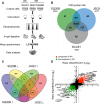Mevalonate pathway activity as a determinant of radiation sensitivity in head and neck cancer
- PMID: 31225926
- PMCID: PMC6717759
- DOI: 10.1002/1878-0261.12535
Mevalonate pathway activity as a determinant of radiation sensitivity in head and neck cancer
Abstract
Radioresistance is a major hurdle in the treatment of head and neck squamous cell carcinoma (HNSCC). Here, we report that concomitant treatment of HNSCCs with radiotherapy and mevalonate pathway inhibitors (statins) may overcome resistance. Proteomic profiling and comparison of radioresistant to radiosensitive HNSCCs revealed differential regulation of the mevalonate biosynthetic pathway. Consistent with this finding, inhibition of the mevalonate pathway by pitavastatin sensitized radioresistant SQ20B cells to ionizing radiation and reduced their clonogenic potential. Overall, this study reinforces the view that the mevalonate pathway is a promising therapeutic target in radioresistant HNSCCs.
Keywords: HNSCC; DNA damage response; mevalonate pathway; radiation sensitivity; senescence; statin.
© 2019 The Authors. Published by FEBS Press and John Wiley & Sons Ltd.
Conflict of interest statement
S.J.K. is a founder of OncoSenescence. The other authors have no conflicts to declare.
Figures






References
-
- Andrews DW, Scott CB, Sperduto PW, Flanders AE, Gaspar LE, Schell MC and Bahary J‐P (2004) Whole brain radiation therapy with or without stereotactic radiosurgery boost for patients with one to three brain metastases: phase III results of the RTOG 9508 randomised trial. Lancet 363(9422), 1665–1672. - PubMed
-
- Bartelink H, Horiot J‐C, Poortmans PM, Struikmans H, Van den Bogaert W, Fourquet A and Wárlám‐Rodenhuis CC (2007) Impact of a higher radiation dose on local control and survival in breast‐conserving therapy of early breast cancer: 10‐year results of the randomized boost versus no boost EORTC 22881‐10882 trial. J Clin Oncol 25(22), 3259–3265. - PubMed
-
- Bjordal K, Ahlner‐Elmqvist M, Hammerlid E, Boysen M, Evensen JF, Biörklund A, Jannert M, Westin T and Kaasa S (2001) A prospective study of quality of life in head and neck cancer patients. Part II: Longitudinal data. Laryngoscope 111(8), 1440–1452. - PubMed
Publication types
MeSH terms
Substances
Grants and funding
LinkOut - more resources
Full Text Sources
Medical
Molecular Biology Databases

